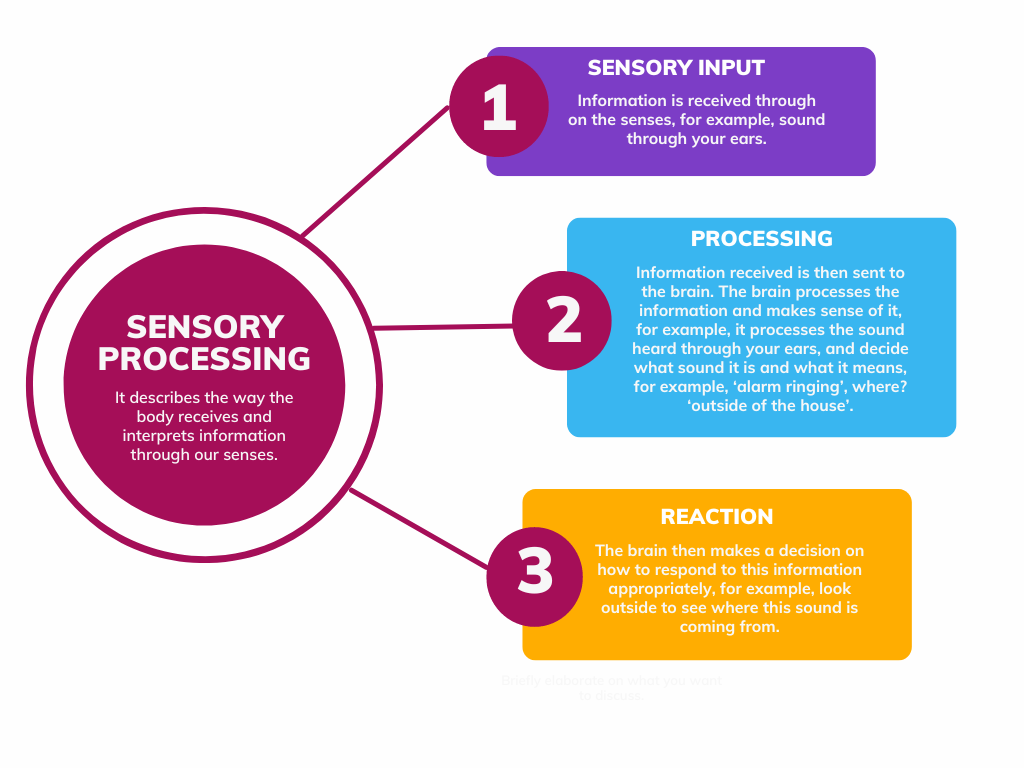Sensory Processing
Sensory processing describes the way the body receives and understands or interprets incoming information through our senses.

Our Eight Senses
We experience life through our eight senses. We have five external senses (1-5) and three lesser known or 'hidden' internal senses (6-8):
- Smell
- Sight
- Taste
- Touch
- Hearing
- Vestibular: the information we receive about movement through the inner ear
- Proprioception: the information we receive from our muscles, ligaments and joints. This tells us where our body is in space
- Interoception: the information we receive from inside our body/organs e.g. hunger, thirst, pain.

Each of us have unique levels of tolerance to sound, movement, images, smells, taste, texture, and touch in our daily lives. This tolerance is determined by the brain and the natural high and low thresholds that we possess. How our nervous system recognises, organises and makes sense of sensory information internally and from the environment affects our behaviours, actions and how we participate in daily activities.
Sensory reactivity
This refers to the regulation of arousal and behavioural responses to sensory input. Often the terms “over-reactive” or “over-responsive” and “under-reactive” or “under responsive” are used in relation to how we react to sensory input.
Behaviours that may indicate some Sensory Processing Difficulties:
- Over activity and/or under activity (lots of jumping OR slow movements)
- Sensory seeking behaviour (touching, squeezing, chewing, smelling)
- Overly sensitive to sensory input (loud noises or certain textures like clothes tags)
- Difficulties with concentration, hard to sit still
- Preference to not be in busy environments, withdrawal or avoidance of some activities or environments.
People are not solely sensory avoiders or seekers; some people demonstrate a combination, however this can depend on multiple factors such as the context that the sensory information is in or how the individual is already feeling.
Self-regulation
Self-regulation is a person’s ability to control their behaviour when responding to a stimulus. Self-regulation involves several components:
- Sensory responses
- Motor responses
- Physiological responses
- Behavioural responses
- Cogntive responses
- Emotional responses
Self-regulation can also refer to a time when our level of arousal is not too low or too high and we are feeling in a state of calm alertness and able to concentrate and participate in activities of daily living.

Supporting Sensory Processing Differences
This is done through a range of activities that offer individuals options to explore different sensory systems.
Lifestyle and Routine
- Maintain a routine and structure to your day
- Try to reduce stress in the family, do not put pressure on yourselves
- A healthy lifestyle which includes a balanced diet and good nutrition
- Exercise
- Having a good social network
- LAUGH and encourage PLAY
Think about the Environment
- Be aware of the environment and modify the intensity of sensory stimuli at home.
- Think about the lighting, the sounds, the smells, the layout of the environment and how that might impact on sensory processing. Is there a quiet space available if there is too much sensory information? Think about how information is picked up by the senses in different environments, at home, in school, in the community.
Sensory-motor activities
- What to consider when choosing activities to aid self-regulation:
- Include a mix of alerting and calming activities
- Use the whole body
- Try something new
- Use heavy muscle work
- Make it fun.
- Proprioceptive and Whole Body Activities: These activities provide movement, deep-touch pressure and heavy muscle work.
- These activities provide regulating input and can have a positive calming and long-lasting impact on the nervous system. Such activities include physical exercise that includes pushing, pulling, dragging, running, jumping, dancing, carrying heavy objects, ball games, yoga stretches, moving furniture or gym equipment.
- You can also try using everyday activities such as household chores that will also provide calming proprioceptive feedback, such as helping to carry in the groceries, taking the laundry out of the washing machine, tidying away toys, wiping surfaces, gardening.
Video
Enable Ireland have created this video on Sensory Processing. This video is part of a six-part series on Neurodiversity, which you can access here.
Further information
- National Autistic Society (UK): Sensory Differences
- Waterford South City CDNT have created this booklet, Sensory Processing - a guide for Parents